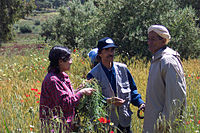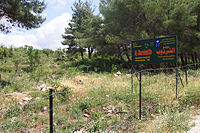- Crop wild relative
-
 Two conservationists collecting indigenous knowledge on cultural practices that favour CWR populations, from a farmer near Fes, Morocco.
Two conservationists collecting indigenous knowledge on cultural practices that favour CWR populations, from a farmer near Fes, Morocco.
A crop wild relative (CWR) is a wild plant closely related to a domesticated plant. It may be a wild ancestor of the domesticated plant, or another closely related taxon.
Contents
Overview
The wild relatives of crop plants constitute an increasingly important resource for improving agricultural production and for maintaining sustainable agro-ecosystems.[1][2][3] With the advent of climate change and greater ecosystem instability CWRs are likely to prove a critical resource in ensuring food security for the new millennium.[4] It was Nikolai Vavilov, a Russian Botanist who first realized the importance of crop wild relatives in the early 20th century.[5] Genetic material from CWRs has been utilized by humans for thousands of years to improve the quality and yield of crops. Farmers have used traditional breeding methods for millennia , wild maize (Zea mexicana) is routinely grown alongside maize to promote natural crossing and improve yields. More recently, plant breeders have utilised CWR genes to improve a wide range of crops like rice (Oryza sativa), tomato (Solanum lycopersicum) and grain legumes.[6] CWRs have contributed many useful genes to crop plants, and modern varieties of most major crops now contain genes from their wild relatives. Therefore CWRs are wild plants related to socio-economically important species including food, fodder and forage crops, medicinal plants, condiments, ornamental, and forestry species, as well as plants used for industrial purposes, such as oils and fibres, and to which they can contribute beneficial traits. A CWR can be defined as "... a wild plant taxon that has an indirect use derived from its relatively close genetic relationship to a crop...”[7]
Conservation of crop wild relatives
 Example of one of the first genetic reserves established to conserve CWRs near Kalakh al Hosn, Syria
Example of one of the first genetic reserves established to conserve CWRs near Kalakh al Hosn, Syria
CWRs are essential components of natural and agricultural ecosystems and hence are indispensable for maintaining ecosystem health.[8] Their conservation and sustainable use is very important for improving agricultural production, increasing food security, and maintaining a healthy environment.[9][10] The natural populations of many CWRs are increasingly at risk. They are threatened by habitat loss through the destruction and degradation of natural environment or their conversion to other uses. Deforestation is leading to the loss of many populations of important wild relatives of fruit, nut, and industrial crops. Populations of wild relatives of cereal crops that occur in arid or semi-arid lands are being severely reduced by over grazing and resulting desertification. The growing industrialization of agriculture is drastically reducing the occurrence of CWRs within the traditional agro-ecosystems. The wise conservation and use of CWRs are essential elements for increasing food security, eliminating poverty, and maintaining the environment.[11]
Examples of Wild Relatives
Grains
Vegetables
Note: Many different vegetables share one common ancestor, particularly in the Brassica family and plants. Many vegetables are also hybrids of different species, again this is particularly true of Brassicas.
- Lettuce - Lactuca sativa
- Cabbage - Brassica oleracea (“Wild Cabbage")
- Leek - Allium ampeloprasum (“Wild Leek")
- Onion - Allium cepa
- Turnip - Brassica rapa
- Brocolli - Brassica oleracea
- Rutabaga - Brassica napus
- Carrot - Daucus Carota (“Wild Carrot”)
Fruits
- Strawberry - Fragaria × ananassa
- Alpine Strawberry - Fragaria vesca
- Cherry - Prunus avium
- Orange - a hybrid between Pomelo and Mandarins
- Banana - A hybrid between Musa acuminata and Musa balbisiana
- Apple - mostly Malus sieversii, but with some cultivars perhaps belonging to Malus sylvestris or being a hybrid of the two.
- Pear - Pyrus communis
- Plum - A hybrid between Prunus spinosa and Prunus cerasifera
See also
References
- ^ Bioversity International, (2006). Crop wild relatives. Bioversity International, Rome.
- ^ FAO, (1998). The State of the World’s Plant Genetic Resources for Food and Agriculture. FAO, Rome
- ^ FAO, (2008). Establishment of a global network for the in situ conservation of crop wild relatives: status and needs. FAO, Rome
- ^ Maxted, N., Ford-Lloyd, B.V. and Kell, S.P., (2008). Crop wild relatives: establishing the context. In: Maxted, N., Ford-Lloyd, B.V., Kell, S.P. Iriondo, J., Dulloo, E. and Turok, J. (eds.) Crop Wild Relative Conservation and Use. Pp. 3-30. CABI Publishing, Wallingford.
- ^ Vavilov, N.I., (1926). Studies in the origin of cultivated plants. Institute of Applied Botany and Plant Breeding, Leningrad.
- ^ Hajjar, R. and Hodgkin, T., (2007). The use of wild relatives in crop improvement: a survey of developments over the last 20 years. Euphytica, 156: 1-13.
- ^ Maxted, N., Ford-Lloyd, B.V., Jury, S.L., Kell, S.P. and Scholten, M.A. (2006). Towards a definition of a crop wild relative. Biodiversity and Conservation 15(8):2673-2685.
- ^ Maxted, N., Ford-Lloyd, B.V. and Kell, S.P., (2008). Crop wild relatives: establishing the context. In: Maxted, N., Ford-Lloyd, B.V., Kell, S.P. Iriondo, J., Dulloo, E. and Turok, J. (eds.) Crop Wild Relative Conservation and Use. Pp. 3-30. CABI Publishing, Wallingford.
- ^ Hawkes, J.G., Maxted, N. and Ford-Lloyd, B.V., (2000). The ex situ conservation of plant genetic resources. pp. 1-250. Kluwer, Dordrecht.
- ^ Heywood, V.H. and Dulloo, M.E., (2006). In Situ Conservation of Wild Plant Species – a Critical Global Review of Good Practices. IPGRI Technical Bulletin No. 11. IPGRI, Rome; Hoyt, E., (1988). Conserving the Wild Relatives of Crops. IBPGR, IUCN, WWF, Rome; Meilleur, B.A. and Hodgkin, T., (2004). In situ conservation of crop wild relatives. Biodiversity and Conservation, 13: 663—684.
- ^ Tanksley, S.D. and McCouch, S.R., (1997). Seed banks and molecular maps: Unlocking genetic potential from the wild. Science, 277: 1063–1066.
External links
- CWR Global Portal
- European Crop Wild Relative Diversity Assessment and Conservation Forum
- CWR Gap Analysis Portal Source on reliable information on where and what to conserve ex-situ, regarding CWR
- [1] A short video on emmer wheat.
- Short DIVERSEEDS video on crop wild relatives in the fertile cresent in Israel
Categories:- Conservation
- Crops
Wikimedia Foundation. 2010.

